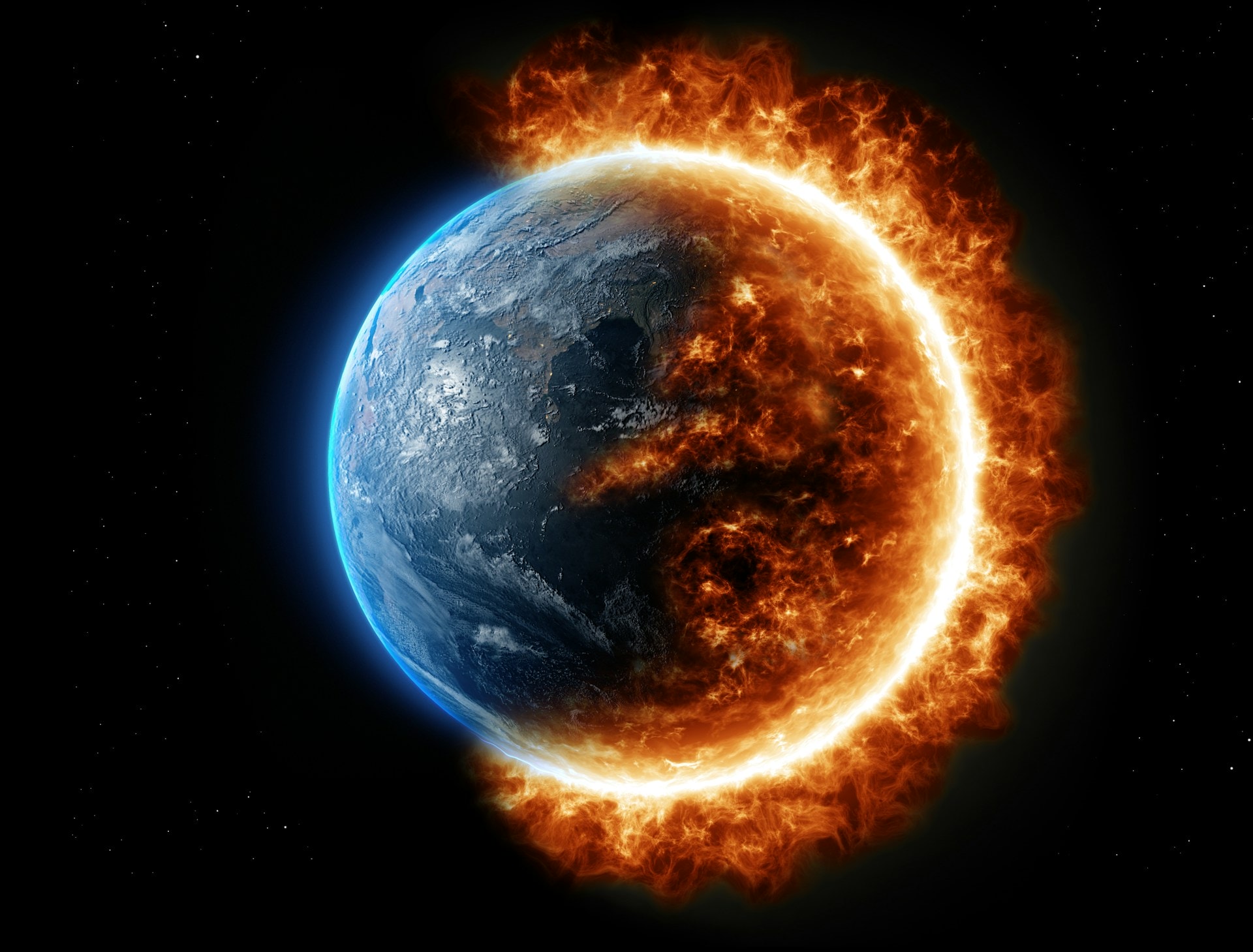Climate scientists have rung the alarm about impending climate doom many times lately, risking the same fate as the child who cried “wolf.” Yet this time, the warning about six climate tipping points is based on more convincing evidence than ever before and therefore deeply troubling.
Consider the case. The harmony of an orchestra relies not only on the skill of the individual musician, but also on the cohesiveness of the larger ensemble.
The earth works much the same.
A spectrum of integrated elements like the polar ice sheets, rainforests, and coral reefs work alone and in unison to maintain the stability of the earth’s systems, loss of which would be catastrophic for humanity and the environment.
However these elements are very sensitive to climate change, and climate scientists have now warned that global warming could have already caused unprecedented damage to five of these core elements, with six close to being pushed past an irreversible climate “tipping point.”
Past a certain climate temperature “tipping point” the stability of certain “tipping elements” like Arctic sea ice, the Amazon rainforest, and the Atlantic Ocean, begins to break down and spiral into a positive-feedback loop of dysfunction.
This spiral is self-perpetuating, and the fallout from one cascade may even trigger other elements’ tipping points – much like the domino effect.

These latest findings come from a recent study that provides an updated climate tipping point roadmap for earth, challenging previous climate change predictions, and setting a new precedent in global warming research.
Worryingly, the results show that even if we are able to meet current climate goals and “net zero” targets, the existing trajectory of climate change could still trigger many more tipping points, spiraling components of the earth’s geosphere, biosphere, cryosphere, hydrosphere, and atmosphere into an increasing state of deterioration.
“The Earth may have left a ‘safe’ climate state beyond 1°C global warming,” the group warns
Due to the self-perpetuating nature of the damage caused to earth past its tipping point, once tipped over the edge the cascade of destruction will continue irreversibly – regardless of whether global warming persists.
Earth is “on course to cross multiple dangerous tipping points that will be disastrous for people across the world,” says Prof Johan Rockström, a scientist from the study.
The group warns that exponential and irreversible damage of this kind could have grave consequences for humanity and the environment.
“To maintain liveable conditions on Earth and enable stable societies, we must do everything possible to prevent crossing tipping points,” says Rockström.
Related Articles: Arctic Summer Sea Ice Could Disappear As Soon As 2035 | The Battle for the Amazon Rainforest: Are the “Lungs of the Earth” Collapsing? | Why Coral Reefs Need All Our Attention | New Study Warns of Gulf Stream Collapse
Why have the “tipping point” predictions changed?
In 2008, a group of climate scientists from the UK and Germany identified a range of potential tipping elements, shortlisting nine elements and their associated tipping points.
They outlined how these large-scale components of the earth’s climate system are at risk of disruption from human-induced climate change, and touched on how early-warning systems could be established, in principle.
They reported that critical climate tipping points could be reached within the century if there is no sustainable intervention – possibly an underestimation in timescale, in reality, it could be much shorter.
Since then, scientific understanding of tipping points has advanced significantly through paleoclimate, observational, and model-based studies, prompting a reassessment of the 2008 report’s findings.
Through analysis of the current literature in the field, the new study now provides an up-to-date list of the 16 most important tipping elements, and reveals how not only is it likely that many tipping points will be reached sooner rather than later, but in fact, in some cases, we may have already triggered them.
They also estimated:
- The temperature at which different tipping points could be triggered
- The impact this would have on Earth and its interconnected systems
- The timescale over which this could occur
We’ve got a new paper out on climate #TippingPoints in @ScienceMagazine: “Exceeding 1.5°C global warming could trigger multiple climate tipping points”https://t.co/KG30p3XXLR
Explainer: https://t.co/LEITA8PhLF
🧵Thread on what it says, & the implications:
1/30 #ClimateChange
— David A. McKay (@davidamckay@mstdn.social) (@dvdmckay) September 9, 2022
The study uncovers that the current state of 1.1°C global warming (past pre-industrial levels), might have already irreversibly pushed 5 of the above elements past their tipping point. These elements possibly affected include Greenland’s ice sheets, the west Antarctic ice sheet, and low-latitude coral reefs, amongst others.
The catastrophic downstream effects of triggering climate tipping points could include rising sea levels, carbon release from thawing permafrost, depletion of biodiversity, and death of biomes like forests and corals.
The shelf’s disintegration in March 2022 has reshaped a landscape where coastal glacial ice was once thought to be stable. https://t.co/ijyxa8Vprk pic.twitter.com/bY9BS91HH6
— NASA Earth (@NASAEarth) March 30, 2022
According to the study, even in the best-case scenario of achieving UN Paris Agreement climate targets to limit warming to 1.5 to <2°C, there’s still a very high probability that six more tipping points will be pushed over the edge.
The six tipping elements at risk are:
- Greenland Ice Sheet collapse
- West Antarctic Ice Sheet collapse
- Collapse of water circulation in the North Atlantic
- Warm-water coral reef loss
- Rapid thawing of Boreal permafrost
- Loss of Barent’s sea ice
In reality, with current policy not expected to meet the UN targets, we are actually on a concerning trajectory of 2 to 3°C warming. According to the study, warming at this rate is likely to trigger up to 10 of the earth’s tipping elements to exceed their thresholds, resulting in “abrupt, irreversible, and dangerous impacts with serious implications for humanity.”
The group state that the study’s findings provide “a compelling reason to limit additional warming as much as possible.”
The study reveals what different versions of our future might look like
The lead author of the study, Dr. David Armstrong McKay, has warned that the destabilisation we are already seeing in the polar regions could be a prelude to tipping points being reached in the region.
With the Arctic warming four times faster than the rest of the world, and Greenland’s melting ice sheet causing sea levels to rise twice as much as previously estimated — the exponential cascade of change is slowly being revealed.
A pair of satellite images acquired almost 50 years apart–by Landsat 1 in 1973 (left) and Landsat 8 in 2022 (right)–reveals striking changes in the glaciers and ice caps of northwest Greenland. https://t.co/c8LisGNwrB pic.twitter.com/9poJ90UgxM
— NASA Earth (@NASAEarth) August 30, 2022
Armstrong McKay does however reiterate that “there are grounds for grief, but there are also still grounds for hope..”
The group aims to bring clarity to the conversation around tipping points, and proposes the implementation of an “early-warning system” to monitor known tipping elements.
Across a variety of possible climate timelines, scenarios, and temperatures, their analysis provides a detailed route map to help us lower the climate-related risks and damage to the planet.
The data suggests that if we are able to meet global targets in limiting the temperature rise to <2°C, then the risks of exceeding tipping points will be reduced.
“The study really underpins why the Paris agreement goal of 1.5°C is so important and must be fought for,” says Armstrong McKay
But even then we’re not out of the woods. Ricarda Winkelmann, one of the scientists leading the study says: “Importantly, many tipping elements in the Earth system are interlinked, making cascading tipping points a serious additional concern.”
By their very nature tipping points are self-perpetuating, meaning the negative effects caused by the breakdown of one, could have knock-on effects elsewhere, and even increase the likelihood of triggering more.
“Every fraction of a degree that we stop beyond 1.5°C reduces the likelihood of hitting more tipping points.” says the group.
The take-home message is clear: unless we take urgent action to mitigate climate change immediately, then many of the critical climate tipping points will be reached, with the real possibility that, in some cases, it might already be too late.
The findings from this study will be vital in setting new climate targets, and informing the policy, infrastructure, and economic resources required to achieve them.
Our next moves will define how the earth’s interconnected tipping elements will collectively determine the future of our planet.
One thing is for sure, if we complacently continue down the path of our current climate trajectory, the whole earth system will be in jeopardy.
— —
Correction: This article has been amended since publication to clarify quotes and add further contextual detail to the “Why have the ‘tipping point’ predictions changed?” section.
Editor’s Note: The opinions expressed here by the authors are their own, not those of Impakter.com — In the Featured Photo: Meltwater from a glacier in Greenland. Featured Photo Credit: NASA Earth Observatory.














